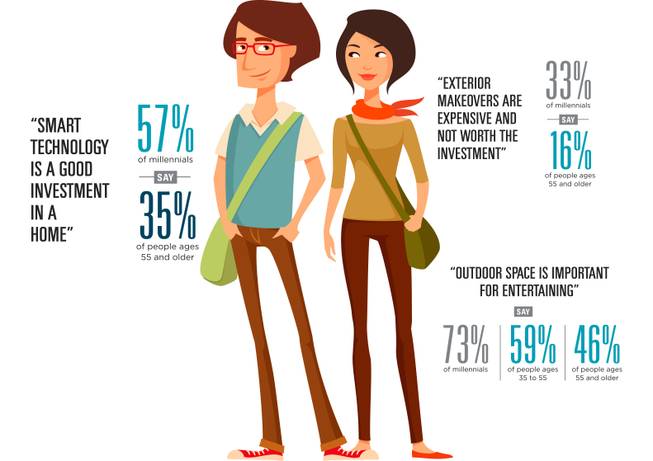
Source: Better Homes and Gardens survey
Monday, March 23, 2015 | 2 a.m.
Related story
The millennial generation is growing up, and they see value in owning a home. Roughly 42 percent of millennials say they want to buy a house in the next five years, compared with just 31 percent of Generation Xers, according to a Zillow survey. But their tastes differ from their parents’. Technology and outdoor living spaces rank high among their priorities, while curb appeal falls at the bottom of the list.
On curb appeal
While most millennials are focused on making living spaces more convenient and comfortable, fewer care about upgrading the front of their home.
On outdoor living spaces
Millennials see outdoor living space as an extension of the home and an important place for family and friends to gather and spend time together. They are much more likely than older generations to use their outdoor space for meals and to decorate it as they would their living room or dining room.
On technology
Millennials say smart technology can be expensive, but they are willing to invest the money because they believe the upgrades save energy, improve safety and make life easier. A majority say they believe such technology can be upgraded and maintained easily and can be customizable to their budgets and needs.
Go green: Gadgets can lower bills, add value
Stroll down the aisles of any home improvement store, and you can find items that will reduce energy and water usage. LED lights here, insulation there, low-flow shower heads a few rows over. ¶ But there’s even more available. Here are a few other options to reduce your utility bills:
Water control valve
These simple fixtures allow users to reduce the flow of water from their shower head as they’re soaping up, without fiddling with the main faucet handle or handles. Combined with a low-flow shower head, they can reduce water usage from showers by 75 percent.
Cost: About $10
Smart plugs
These adapters plug into wall sockets and can be controlled with smartphone apps to remotely turn on and off lights and electronic devices or preprogram them so they’ll draw less energy when people aren’t home or the household is asleep. They also contain motion sensors so lights stay on only when rooms are occupied.
An additional bonus: The apps can be used to track energy use by room or device.
Cost: $30 and up
Smart power strips
Even when appliances and devices are shut off, they draw power if they’re still plugged in. Same for chargers for smartphones and tablets when they become fully charged.
A smart strip senses when the devices plugged into them are fully charged or not in use, then cut the power to them. In doing so, the strips eliminate energy “vampires,” which draw a significant amount of power.
Cost: About $30
Tankless water heater
Traditional water heaters use a lot of energy keeping large amounts of water hot at all times. Tankless heaters work by warming water as it flows through them, like a pool heater, so they consume less energy because they’re generally not in use as often.
The downside is they’re not cheap, so it can take years to realize enough energy savings to get a return on your investment.
Cost: $600 to $1,200
Induction cooking ranges
Unlike a gas stove that uses a flame or an electric stove that uses a heating coil, an induction device works by producing a magnetic field that doesn’t create any heat itself but causes special metal cookware to be heated.
The cooking surface remains cool to the touch (a pot of water can be brought to boil while sitting on a piece of paper, and the paper won’t burn.) It also works almost instantaneously. Turn on the “burner,” and water in a pot starts to boil in the blink of an eye.
It’s complicated, but it’s much more energy efficient than a traditional electric device. It’s also much more expensive.
Cost: $1,529 and up
Ric Anderson contributed to this story.

Join the Discussion:
Check this out for a full explanation of our conversion to the LiveFyre commenting system and instructions on how to sign up for an account.
Full comments policy